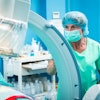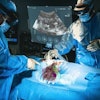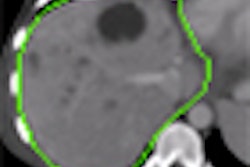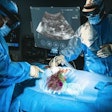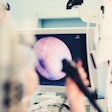With increasing requirements for 3D in today's fast-paced imaging practice, institutions have a lot to think about when deciding whether to implement a 3D lab, according to Dr. Bradley Erickson, Ph.D., of the Mayo Clinic in Rochester, MN.
"You need to involve all physicians early and keep them involved, so that they feel ownership," Erickson said. "And then you need to agree on realistic expectations, and you need to think about the right model for providing that service and the right service level."
In today's imaging world, 3D is being used in many applications, including CT angiography (CTA) and MR angiography (MRA) studies, preprocedure planning, and as a communications tool with other physicians and patients, Erickson said. In addition, nonvisualization processing is important for many new quantitative imaging methods such as diffusion tensor imaging, tumor measurements, computer-aided detection, and CT colonography, he said.
"When we talk about 3D, it's not just 3D rendering. You're going to see more and more applications that are about 3D processing," he said during a session at the Society for Imaging Informatics in Medicine (SIIM) annual meeting in June.
There are many advantages to having a 3D lab, including higher standardization, use of dedicated hardware and software, and allowing for a higher level of operator expertise thanks to utilization of dedicated 3D technologists, he said. A 3D lab should also allow for greater efficiency of scale and a single point of contact for 3D work.
A 3D lab can also be a great way to unite an enterprise, Erickson said. "These systems are expensive and to expect every department to have a 3D-type system is probably unrealistic," he said. "A central resource and distributed work model can really enhance teamwork."
To really do a 3D lab well, C-level executive buy-in is required from the start, however. "This really is a team effort, and you need to figure out how to build a team and be successful," he said.
For those who think a 3D lab could be a huge moneymaker, that's unlikely to be the case, Erickson said. For starters, 3D is bundled into CTA/MRA procedure codes, and it can be easy for others to cherry-pick pieces of work. Also, revenue generated by increasing staffing of scanners is often greater than revenue generated from a 3D lab.
"So don't go into this expecting this is going to be a printing press for money," he said. "Usually you can at least be positive, but it isn't going to be a huge thing."
3D labs aren't for everyone, however. For example, 3D activities will retain a closer connection to current workflow without one, he said.
"You have the same CT tech that did the CT scan now producing the renderings," he said. "They know which ones need to be done, which have been done, and which haven't been done. And so workflow can potentially be easier if that's how you organize your work."
Cost for space, hardware, and people can also be a concern for some institutions. "If you aren't buying special hardware, and you don't happen to have the space for a dedicated 3D lab, you could potentially have lower cost," he said.
Need for speed
Once the decision is made to implement a 3D lab, it's important to decide on the service level the lab will provide. This includes figuring out how fast results will be produced, how it will be integrated with the workflow of radiologists and others, and how off-hours studies will be handled, Erickson said.
The speed requirements for 3D and image processing vary. In some cases, it's necessary or helpful for interpretation; this demands a high service level, Erickson said.
"If it takes four hours for you to produce the renderings, and the expectation of the radiologist is that he has to have his report done in an hour, you've got a problem," he said. "And so you have to figure out how to meld those two issues."
Ideally, the 3D lab results need to be integrated into the exam and be part of the product available to the referring physician.
Some 3D, however, is more focused on treatment planning outside of radiology. This could lead to a variable service level, and it's less clear if or how to integrate this information into the radiology exam, Erickson said.
Many radiology departments now have turnaround time (TAT) metrics, and it can be a problem if 3D postprocessing is not completed within the target TAT. Also, the value of 3D for interpretation is often perceived as low for routine cases, he said.
"The consequence is that radiologists often simply do not want to wait for a 3D lab to report a case, and that creates some tension," he said. "I do think that will change as we get a younger generation who is used to using 3D."
For cases requiring 3D after hours, Erickson said that most 3D systems now have thin-client options that can function well as a teleradiology system. This is important, as emergency cases, including complex fractures, bullet wounds, pulmonary embolism studies, and angiography, often can really benefit from 3D, he said.
"And yet, unless you're staffing with routine 3D lab personnel in the middle of the night, you've got the radiologist, who may not be the best operator, running it," he said. "So that's the challenge. But there will be questions about 'why we can't do 3D in the middle of the night' if you don't offer it, so you'll need to have an answer or you need to have a solution for that," he said.
As for 3D postprocessing workflow, an Integrating the Healthcare Enterprise (IHE) profile exists that specifies transactions for 3D postprocessing. However, few vendors have implemented this, he said.
"This is something that you really need to push for, because if you don't have this type of electronic communication, you end up with pieces of paper and telephone calls and things falling through the cracks," he said.
Location
There are a number of considerations to take into account when deciding where the 3D lab should be based, including whether to have a centralized lab with dedicated lab technologists. This should ideally be near the radiology department to encourage interaction between the 3D lab and the radiologists working with the product, he said.
If radiologists are the primary 3D users, the workstation -- ideally a thin-client application integrated into the PACS -- could be utilized in the radiology reading room.
In addition, institutions need to determine how to deliver the 3D results to clinicians and patients, as well as provide for teleradiology and home use, he said. Integration outside of radiology is also needed, as therapy planning often requires 3D.
"Ideally, imaging experts in a 3D lab would do the image preparation and would at least tee things up for the physician," he said. "Therapeutic planning then takes the hand-off and applies the planning steps, saying for instance, 'I want this type of aortic graft' or 'I want this type of a hip prosthesis.' "
The plan must be available to other locations, such as a surgical planning area and operating room. Other physicians must also be able to see the plan, such as for preoperative consultations between radiology and surgery, for example.
A central lab can increase resource efficiency, providing one location for data access, one knowledge base for 3D creation, and a means for providing services across the enterprise, Erickson said.
A 3D lab also needs to provide support for external referrals, Erickson said. This involves, for example, issuing and maintaining secure log-in capability, perhaps with a virtual private network (VPN). This kind of service may also function as a competitive differentiator.
"If a referring physician can access your 3Ds, and a competing radiology practice doesn't do that, they might say, 'I'm going to pick you next time,' " he said. "It's appealing to many physicians, and primary care physicians are increasingly starting to enjoy and use 3D as a way of communicating with patients. And so it can really improve communications and collegiality if you structure your 3D lab well."
Another option is to simply outsource the 3D lab. This is a good option if volume is low or highly variable, physician expectations are beyond available resources, capital is restricted, you're in an area where you're going to have difficulty hiring the necessary technologists, or local IT support is restricted or overtaxed, he said.
By Erik L. Ridley
AuntMinnie.com staff writer
July 10, 2009
Related Reading
Dedicated 3D server speeds up CT data processing, June 6, 2009
Enterprise-wide 3D extends radiology's boundaries, June 2, 2009
Turning your 3D lab into a profit center, May 21, 2009
3D development outpaces facilities' readiness, June 23, 2009
3D labs add value for radiology -- if managed properly, May 20, 2008
Copyright © 2009 AuntMinnie.com


